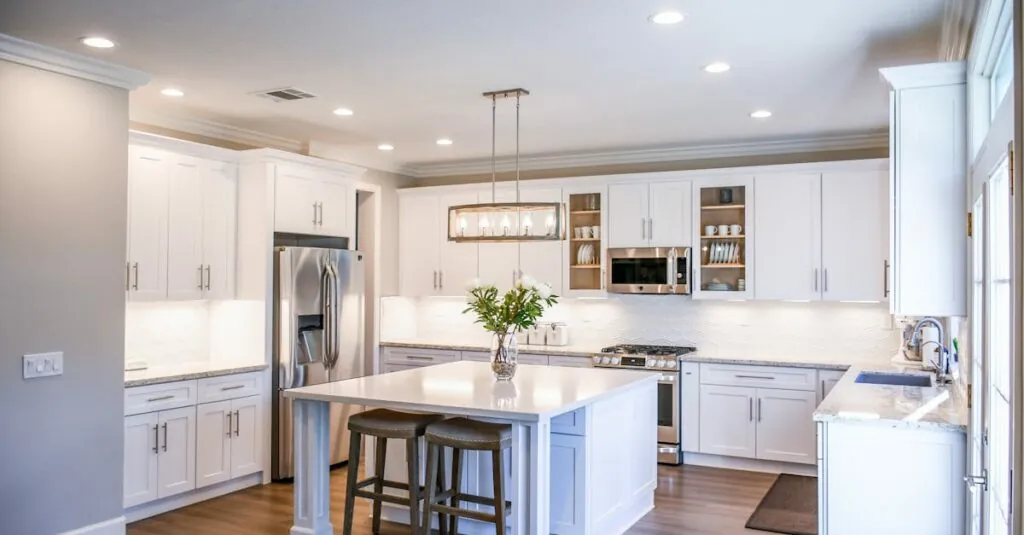Table of Contents
ToggleTransforming a kitchen can feel like a daunting task, but what if there’s a way to elevate your space without breaking the bank? Enter the DIY kitchen island made from stock cabinets. It’s the perfect solution for those who want to add style and functionality without sacrificing their savings or sanity.
Overview of DIY Kitchen Islands
DIY kitchen islands provide an accessible way to upgrade kitchens using stock cabinets. Stock cabinets, available in various sizes and styles, offer flexibility for customization. Kitchen islands created from these cabinets enhance storage and workspace without excessive expenses.
Creating a DIY kitchen island requires minimal tools and skills, making it approachable for most homeowners. Many opt for a straightforward installation that includes cabinet assembly and surface attachment. Seek cabinets that match existing kitchen decor for a cohesive look.
Design options abound, from simple rectangular shapes to more elaborate L-shaped islands. Choosing counter materials adds another level of personalization. Granite, butcher block, and laminate each present unique benefits and aesthetic appeal.
Planning ensures proper sizing and positioning within the kitchen layout. Measure available space while considering structural elements such as doorways and windows. It’s crucial to account for added electrical needs if incorporating appliances or outlets within the island.
Adding accessories, like open shelving or stools, customizes functionality further. Accessories improve accessibility to often-used kitchen items, streamlining cooking processes. Seating arrangements foster a social gathering space, extending kitchen usability beyond meal prep.
Overall, DIY kitchen islands made from stock cabinets effectively amplify kitchen functionality and style. Integrating these islands not only revitalizes the kitchen but also provides practical solutions for everyday use. Embracing this project results in a personalized space tailored to individual needs.
Benefits of Using Stock Cabinets
Stock cabinets provide numerous advantages for homeowners looking to create a DIY kitchen island. The straightforward assembly process and broad availability make them a popular choice.
Cost-Effective Solutions
Stock cabinets offer affordability compared to custom options. Most homeowners find that these cabinets typically range from $50 to $300 per unit. Choosing stock cabinets allows individuals to stick to a budget while still achieving a stylish look. Savings may increase further through discounts and promotions often available at big-box retailers. Their pre-fabricated nature also means less wait time, enabling quick project completion.
Easy Accessibility
Purchasing stock cabinets remains convenient through various retailers, both online and in-store. Most local home improvement stores carry a selection of sizes and styles. This accessibility facilitates quick decision-making and immediate purchase. First-time DIYers appreciate the user-friendly design and straightforward instructions that accompany stock cabinets. Additionally, many brands offer compatible materials like countertops and hardware, simplifying the renovation process further.
Planning Your DIY Kitchen Island
Proper planning is crucial for a successful DIY kitchen island project. Homeowners should focus on measuring their space accurately and selecting the right cabinets.
Measuring Your Space
Start by determining the desired dimensions for the kitchen island. Consider the available floor space and the kitchen’s overall layout. Measurements should include the length, width, and height to ensure the island complements existing features. Maintaining clear walkways around the island enhances movement and access. Maintaining a minimum clearance of 36 inches between the island and surrounding cabinets or appliances promotes comfortable cooking and dining. Document all measurements to guide cabinet selection.
Choosing the Right Cabinets
Selecting cabinets requires attention to both style and function. Stock cabinets offer various options in terms of materials, colors, and finishes, enabling homeowners to match their kitchen’s aesthetics. Budget constraints play an important role, as costs typically range from $50 to $300 per cabinet. Evaluating the cabinet’s quality ensures durability and longevity. Assess the configuration to fit specific layout needs, aiming for a combination of closed storage and open shelving. Cheaper models tend to lack sturdiness, so prioritizing robust construction leads to better performance.
Assembling Your Kitchen Island
Assembling a DIY kitchen island from stock cabinets involves straightforward steps and a few essential tools and materials. He or she should gather everything needed before starting to ensure a smooth process.
Tools and Materials Needed
Important tools for this project include a power drill, screwdriver, level, measuring tape, and a circular saw for precise cuts. Gathering materials like stock cabinets, screws, wood glue, and cabinet hardware is essential for a solid assembly. Select a countertop made from durable materials, such as granite or laminate, to enhance the island’s functionality. Additional items like cabinet supports and finishing paint may also be necessary to create a polished look.
Step-by-Step Assembly Process
Begin by laying out the cabinet units in the desired configuration. Align the cabinets carefully, ensuring they fit the planned layout. Fasten cabinets together using screws to secure them in place. Once assembled, check that everything is level, adjusting as needed. Next, attach the countertop to the framed structure, reinforcing it with wood glue and screws. Finally, finish any visible areas with paint or trim for a clean and stylish appearance.
Customizing Your Kitchen Island
Customization enhances the functionality and aesthetic appeal of a DIY kitchen island. Stock cabinets provide a solid foundation, allowing ample opportunities for personalization.
Adding Countertops
Choosing countertops significantly impacts the overall look of the island. Materials such as granite, butcher block, and laminate offer various styles and durability options. Granite surfaces provide a high-end appearance, while butcher block adds warmth and a rustic charm. Laminate remains budget-friendly, coming in an array of colors and patterns. Installation typically requires precise measuring and cutting. Aligning the countertop with the cabinets ensures a seamless finish. Homeowners should consider the maintenance needs of each material. For example, granite requires sealing to prevent staining, whereas laminate resists scratches and heat.
Incorporating Storage Solutions
Effective storage solutions maximize the utility of the kitchen island. Stock cabinets often come with built-in drawers and shelves for organization. Open shelving offers an excellent display space for decorative items or frequently used kitchenware. Including hooks or racks on the sides provides additional hanging storage for utensils or towels. Accessories like baskets can also enhance storage versatility. Choosing cabinet styles that complement existing kitchen decor creates a cohesive look. Assessing the available kitchen space helps in determining the right balance of closed and open storage options. This thoughtful approach ensures the island remains functional and inviting.
Creating a DIY kitchen island from stock cabinets is an empowering project that can significantly enhance any kitchen’s style and functionality. By utilizing readily available materials and straightforward assembly techniques, homeowners can craft a personalized space that meets their unique needs.
With careful planning and attention to detail, the possibilities for customization are endless. Whether opting for a simple design or a more intricate layout, the result is a stylish and practical addition to the kitchen. This approach not only keeps costs manageable but also encourages creativity and satisfaction in home improvement. Embracing this DIY project can lead to a transformed kitchen that reflects individual taste and lifestyle.




